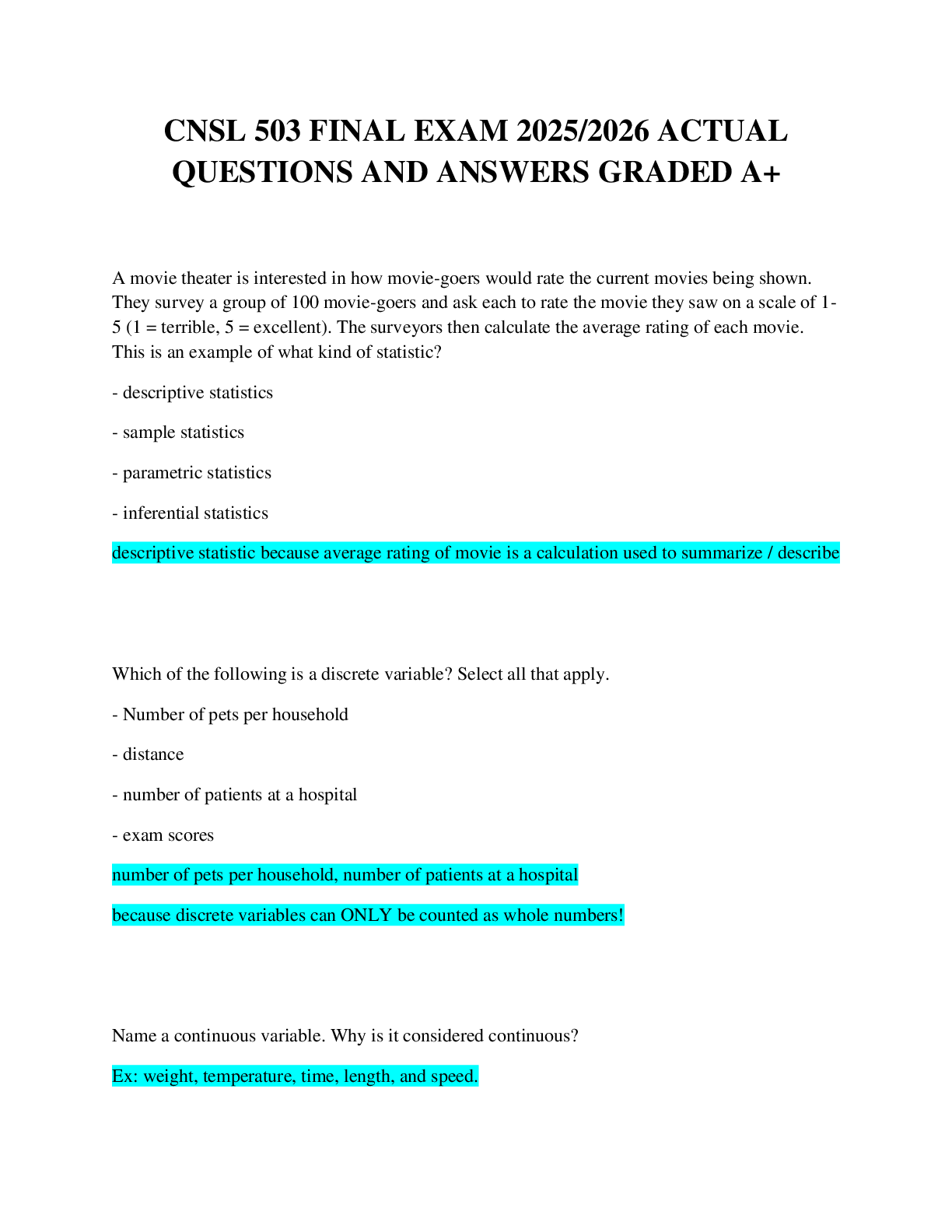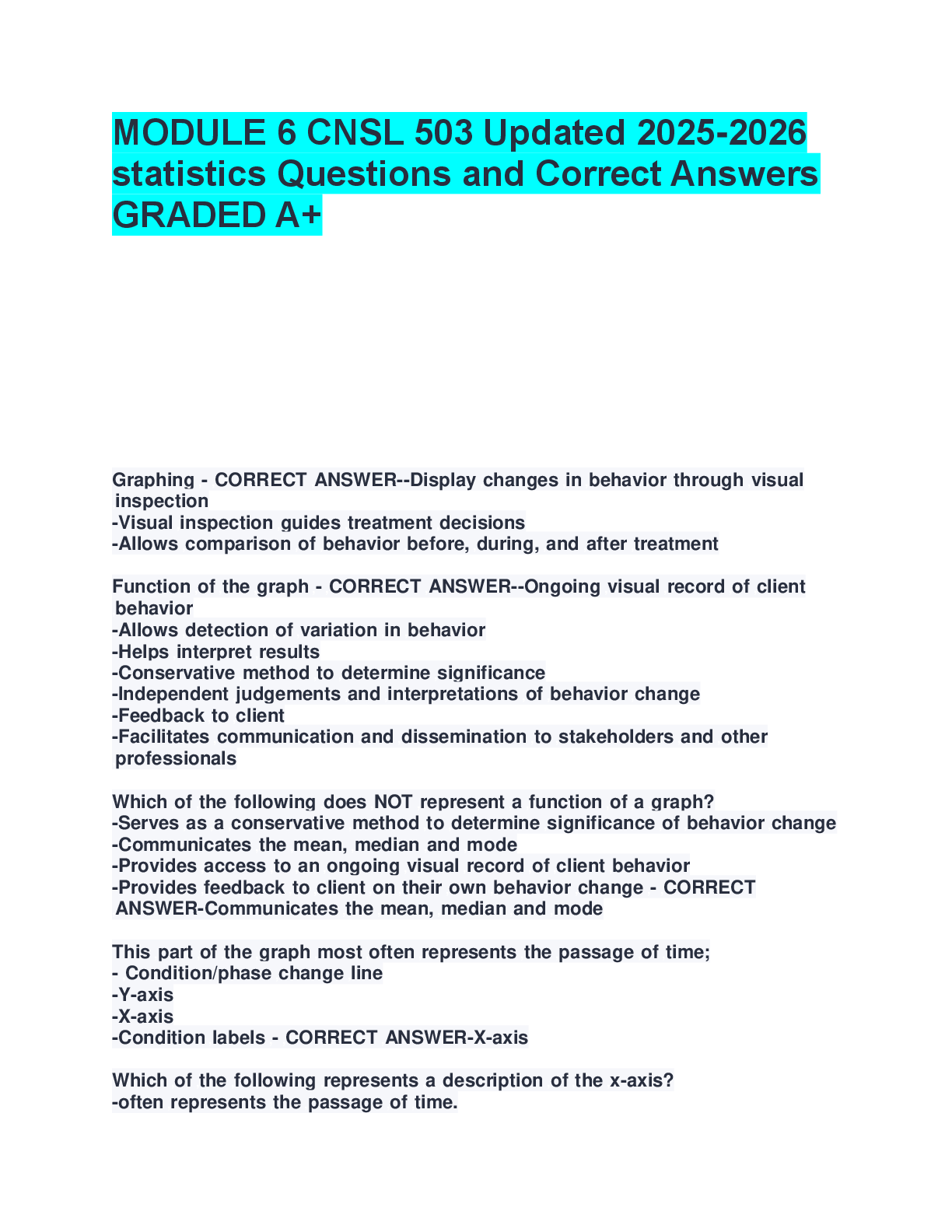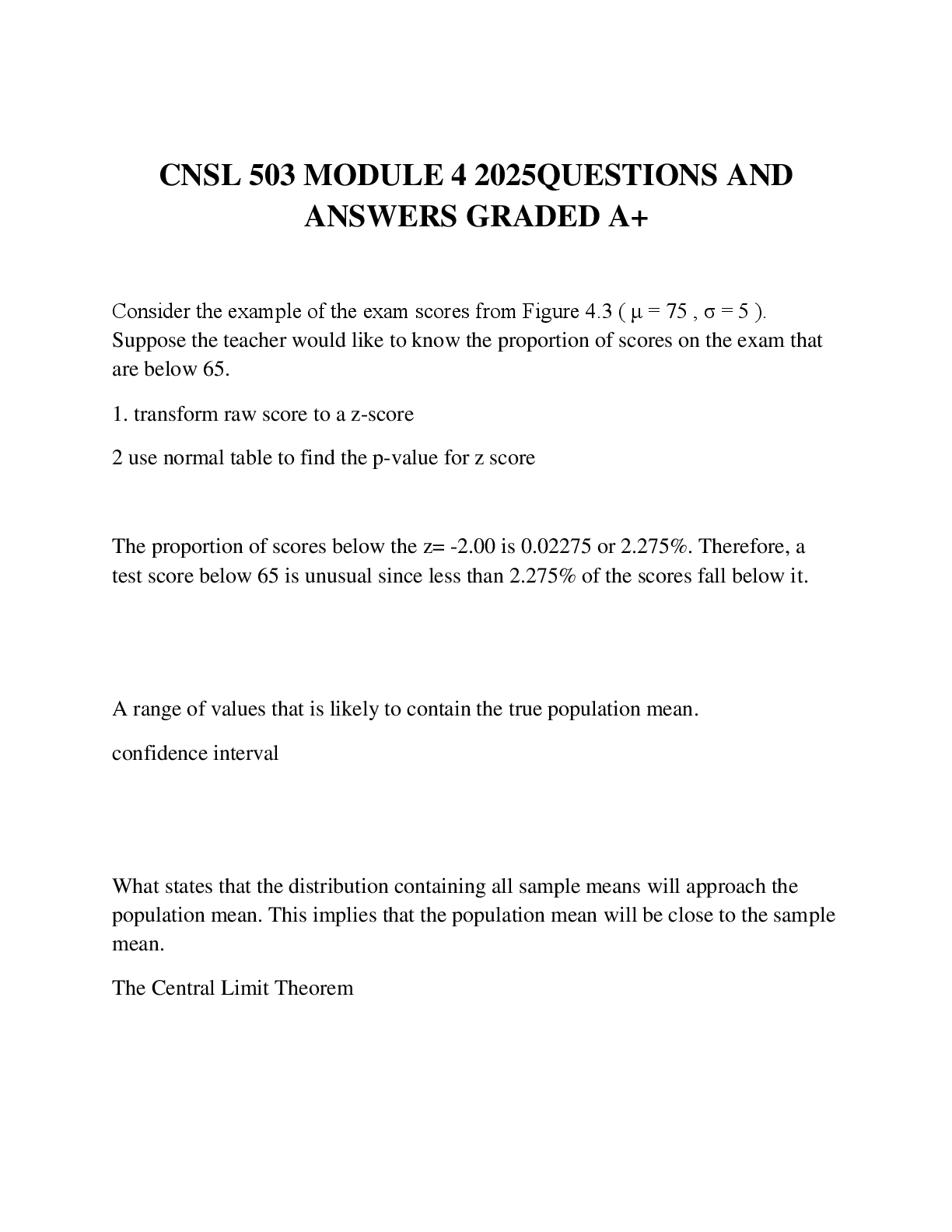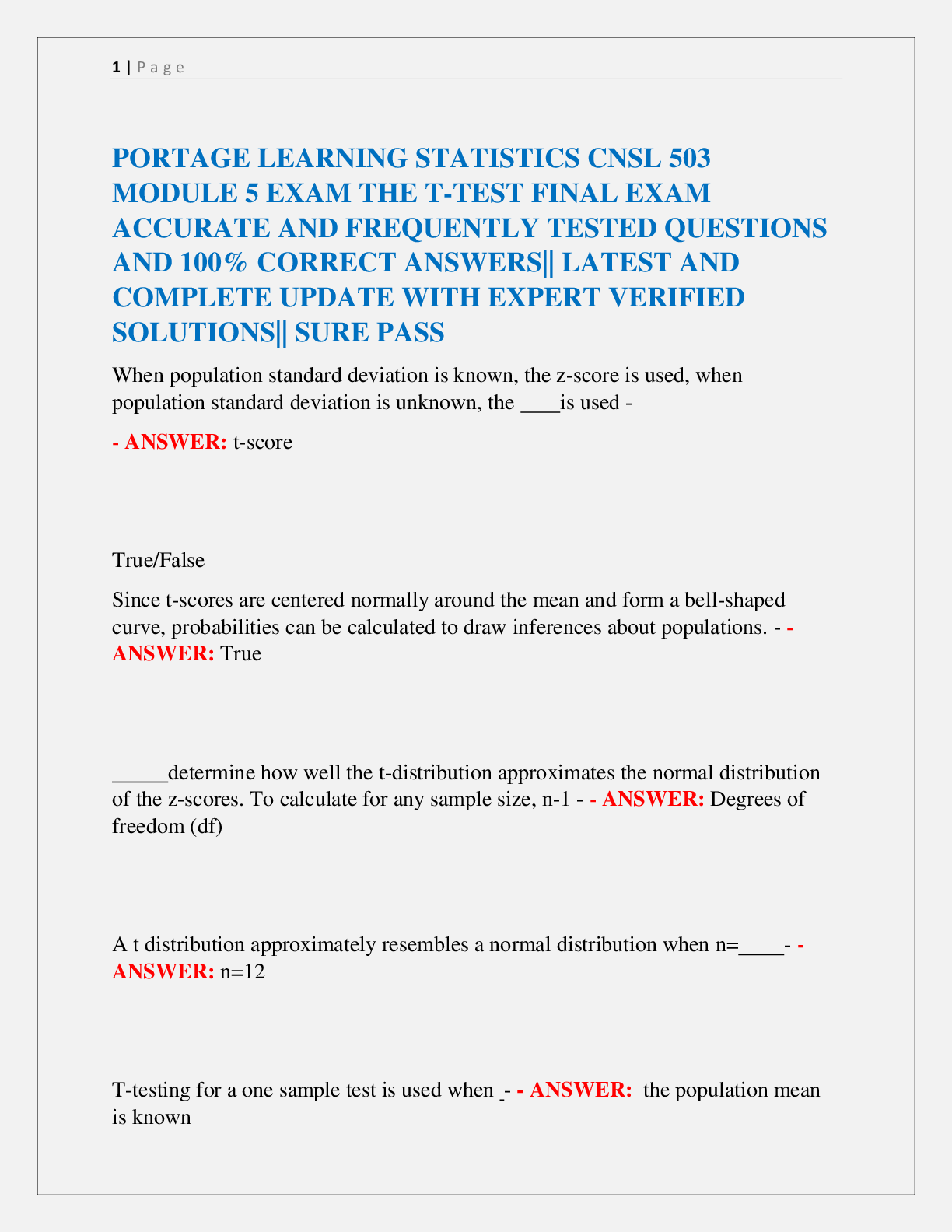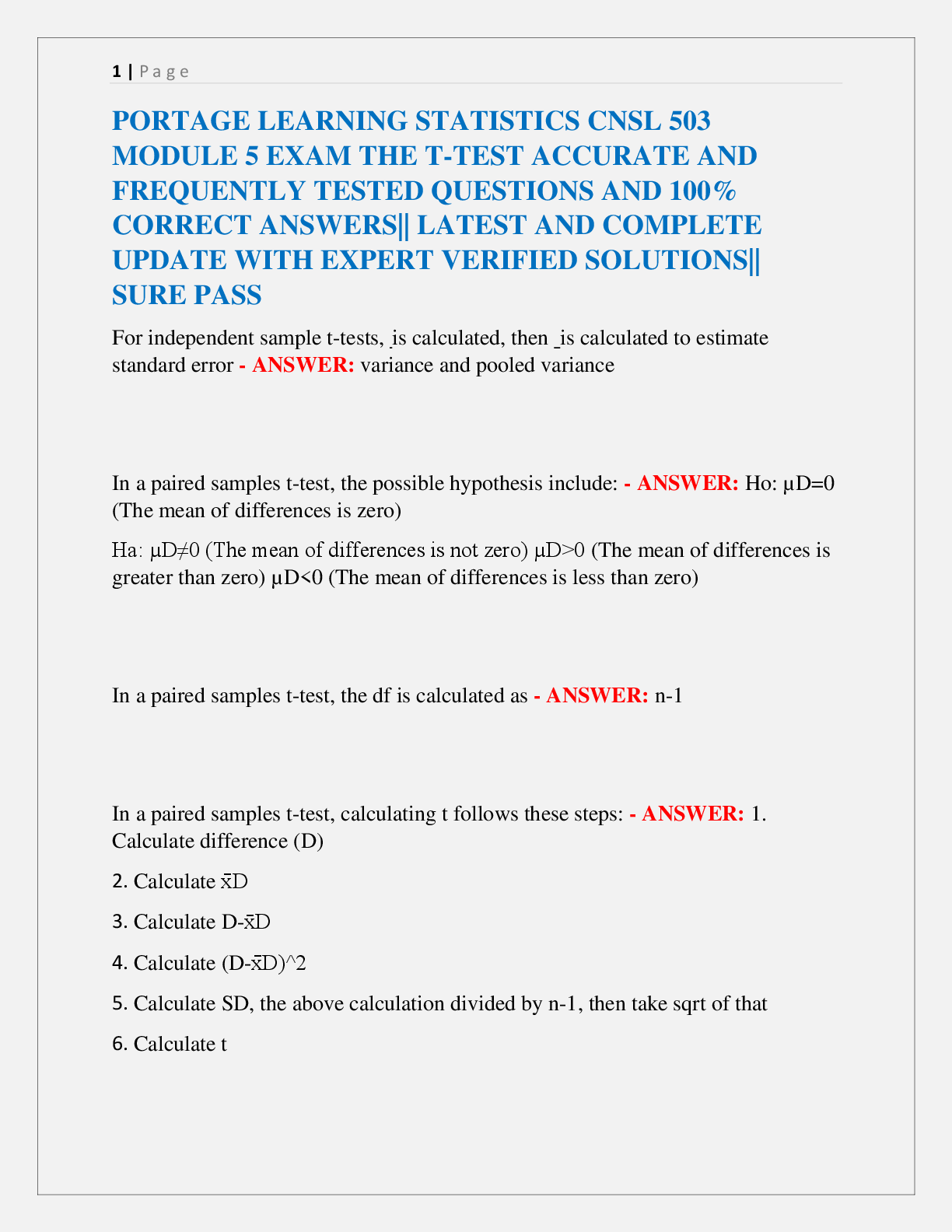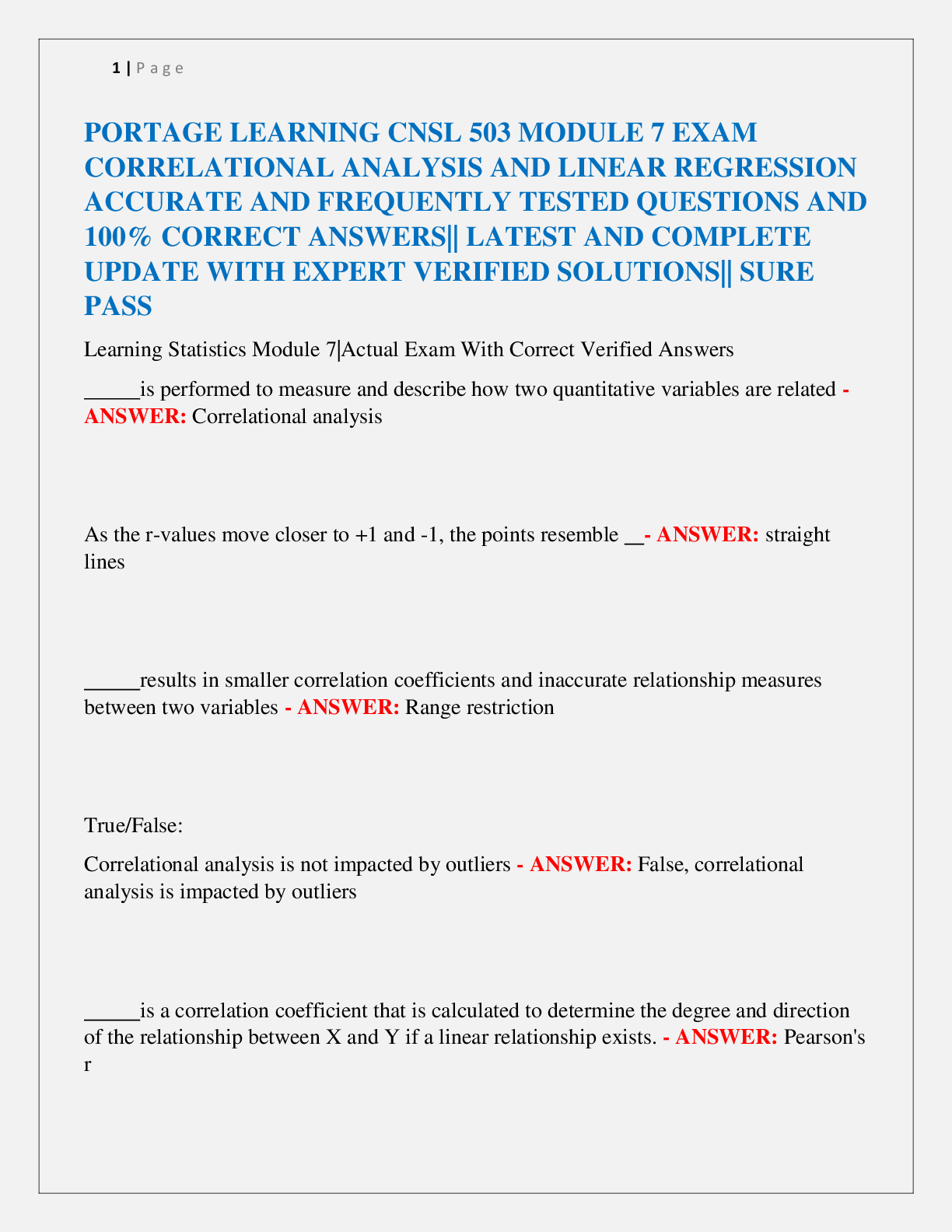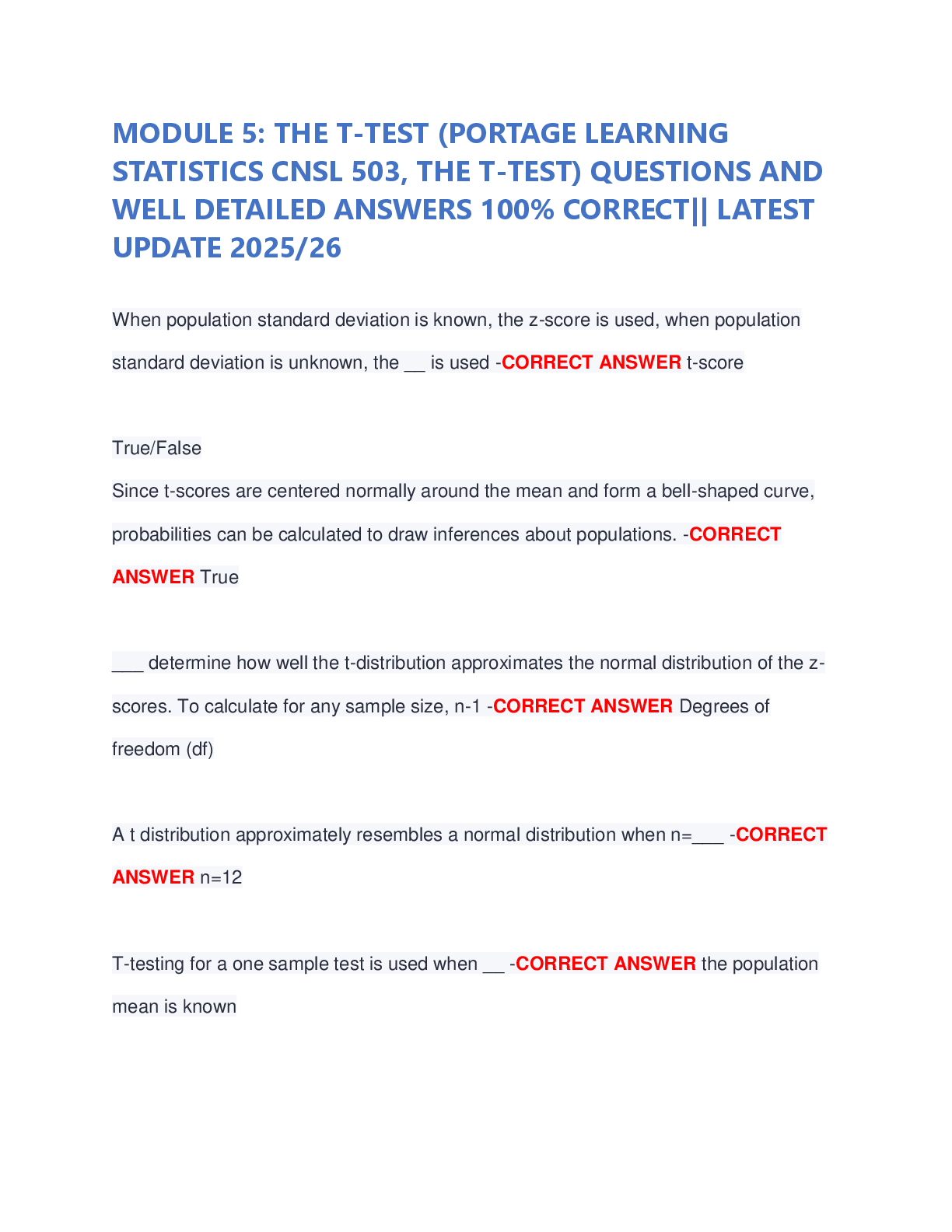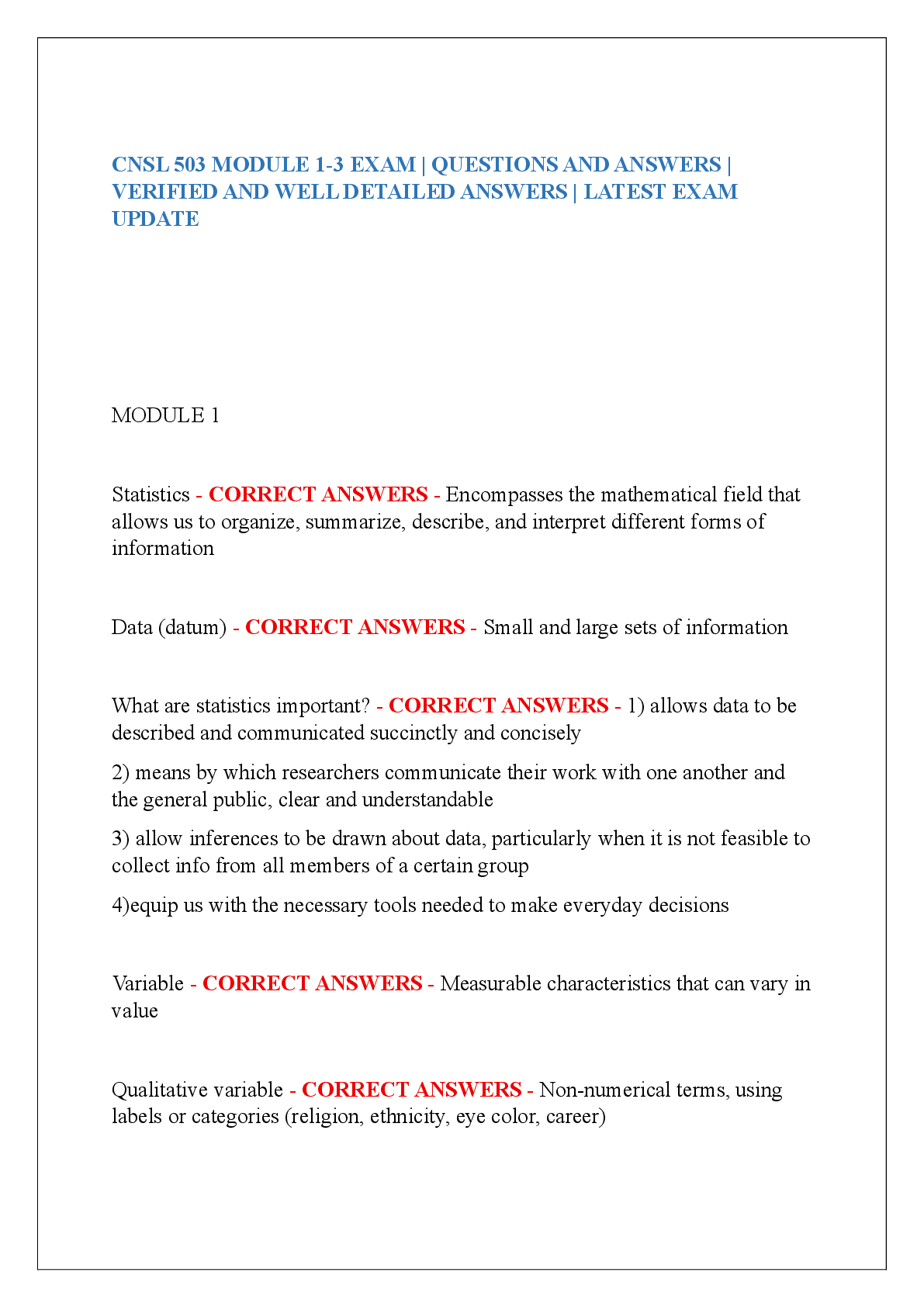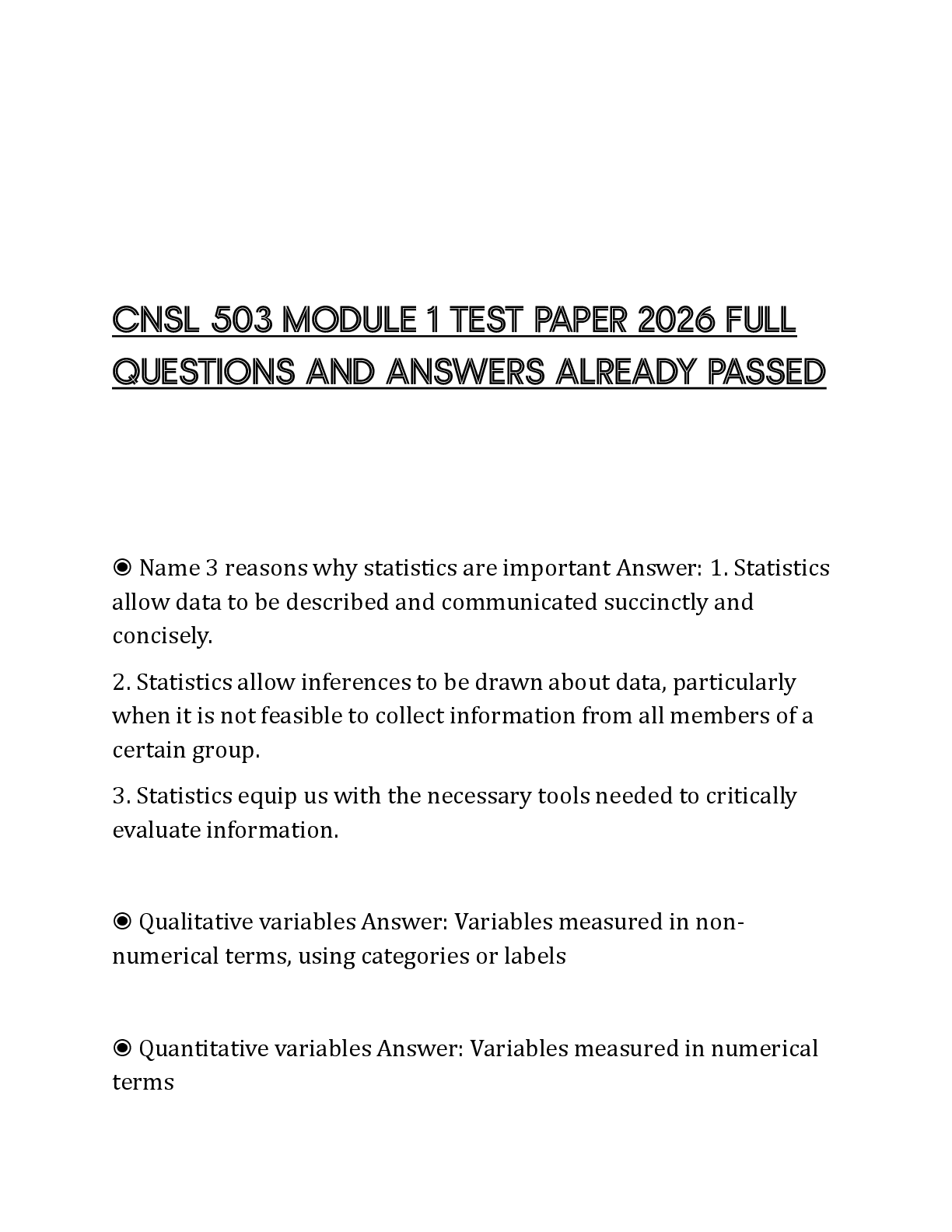BioChemistry > EXAMs > C785 Kaleys_Comprehensive_Study_Guide_final 2020 | Biochem_Kaleys_Comprehensive_Study_Guide_final _ (All)
C785 Kaleys_Comprehensive_Study_Guide_final 2020 | Biochem_Kaleys_Comprehensive_Study_Guide_final _ Graded A
Document Content and Description Below
Biochemistry: Mod 1 DNA = phosphate + deoxyribose sugar + A/T/C/G o Contains two strands. The strands are antiparallel (opposite each other). o 5’ → 3’ 3’ ← 5’ RNA = phosphate + ri ... bose sugar + A/U/C/G o Single strand, can fold back onto itself and form pairs between itself (stem‐loop). Each nucleic acid is made up of polymers (many monomers) that are called nucleotides. o Nucleotides contain one or more phosphates, a five‐carbon sugar, and a nitrogen base. o Nucleotides are always made in the 5’ to 3’ direction. o 5 is always the beginning of the strand, 3 is the end where nucleotides are added. DNA organization: DNA is wrapped around proteins called histones → nucleosome → chromaƟn fiber→ chromosomes Steps to the central dogma: o Coding DNA → template DNA → mRNA → tRNA (amino acid) o DNA → transcribed to mRNA → translated to protein o Each step is complementary (opposite) to the previous step, but if you skip a step it will be identical to the previous step. o Example 1. Coding DNA strand 5’ AAA TTT GGG CCC 3’ 2. Template DNA strand 3’ TTT AAA CCC GGG 5’ 3. mRNA 5’ AAA UUU GGG CCC 3’ 4. tRNA Lys Phe Gly Pro Pairing: o DNA: A → T o RNA: A → U DNA replication: o Because DNA is a double helix, one strand can be separated and serve as a template for synthesis of a new strand. o Semi‐conservative: each copy of DNA contains a template strand and a new strand. o Steps of replication:Page 2 of 39 o 1. The DNA must be separated, creating a replication fork. This is done by helicase. o 2. Primase attaches an RNA primer, where the replication is to start. o 3. DNA polymerase adds bases to the remaining of the strand until it reaches a stop codon. This is done in fragments, called okazaki fragments. If an error is detected, it removes the nucleotides and replaces them with correct ones, known as exonuclease. o Exonuclease removes all of the RNA primers, and DNA polymerase fills in those gaps. o DNA ligase seals the two strands forming a double helix. DNA → transcribed → mRNA → translated → protein Transcription occurs in the nucleus: o Initiation: RNA polymerase binds to a sequence of DNA called the promoter, found near the beginning of a gene. Each gene has its own promoter. Once bound, RNA polymerase separates the DNA strands, providing the single‐stranded template needed for transcription.Page 3 of 39 o Elongation: One strand of DNA, the template strand, acts as a template for RNA polymerase. As it "reads" this template one base at a time, the polymerase builds an RNA molecule out of complementary nucleotides, making a chain that grows from 5' to 3'. The RNA transcript carries the same information as the non‐template (coding) strand of DNA, but it contains the base uracil (U) instead of thymine (T). o Termination. Sequences called terminators signal that the RNA transcript is complete. Once they are transcribed, they cause the transcript to be released from the RNA polymerase. o Pre‐mRNA must go through extra processing before it can direct translation. They must have their ends modified, by addition of a 5' cap (at the beginning) and 3' poly‐A tail (at the end). Pre‐mRNAs must also undergo splicing. In this process, parts of the pre‐mRNA (called introns) are chopped out, and the remaining pieces (called exons) are stuck back together.Page 4 of 39 Translation occurs in the cytoplasm: o Initiation: The ribosome assembles around the mRNA to be read and tRNA brings in its perspective protein, decoding 3 bases at a time, beginning with the start codon, AUG. o These 3 base pairs of mRNA are called codons. The mRNA base pairs are complementary to the base pairs of the tRNA, called anticodons. o Elongation: The amino acid chain gets longer. The mRNA is read one codon at a time, and the amino acid matching each codon is added to a growing protein chain. When the complementary pairs are formed, they are added to the protein chain by peptide bonds, the result is polypeptides. o Termination: The finished polypeptide chain is released when a stop codon (UAG, UAA, or UGA) enters the ribosome. Gene regulation o Promotor sites: can be turned off or on, enabling or disabling a gene from being replicated. o Alternative splicing: Exons are used to code for protein, introns are clipped out. The order of exons can determine different mature mRNA strands which result in different proteins. o Epigenetics: involves packaging of DNA. DNA is round around histones. These packages are called nucleosomes. How tightly packed they are determines whether or not the gene is on or off.Page 5 of 39 o Loosely packed = transcription possible. o Tightly packed = transcription impeded. o Modifications determine how tightly/loosely packed they are. Many of these modifications are determined by environment/diet. Mutations‐ Mutations originate at the DNA level, but show their effects at the protein level. o Point mutations‐ when one of the DNA bases (nucleotides) are replaced with another, results in a different protein o Example: Coding: 5’ AAA TTT GGG CCC 3’ = Lys Mutation: 5’ TAA TTT GGG CCC 3’ = stop codon o Missense mutations‐ any mutation that causes a change in amino acid o Nonsense mutations‐ leads to a stop codon “stop the nonsense” o Silent mutations‐ doesn’t affect the protein at all, the codon results in the same protein o Frameshift mutations‐ adds one base into the protein sequence, but changes the final protein amino acids by causing a shift. Insertion mutation‐ can change the entire read of the protein Deletion mutation‐ can change the entire read of the protein Conservative mutations‐ where the resulting amino acid is in the same type as the original Non‐conservative mutation‐ amino acid is a different type than the originalPage 6 of 39 Repairing Mutations o Damage to single nucleotide bases from harmful molecules (chemicals or oxygen). o Repair: Base excision‐ replace with a base that isn’t damaged. 1. DNA repair enzymes recognize the damaged base, removes it. 2. DNA polymerase fills the gap with a new base. 3. Ligase seals the gap. o Damage from UV causes multiple damaged nucleotides, ie causing two thymine’s to fuse together (called thymine dimers). o Repair: Nucleotide excision repair‐ removes 20‐30 nucleotides to fix damage. 1. DNA repair enzymes recognize damage, cuts out damage and surrounding area. 2. DNA polymerase fills in the gap with new bases. 3. Ligase seals the gap. o Base mismatch due to errors in replication. o Repair #1: DNA polymerase proof reading. Removes incorrect base, inserts correct base. o Repair #2: Mismatch repair‐ fixes the mismatch 1. DNA repair enzymes recognize mistake, and remove several bases surrounding the mismatch. 2. DNA polymerase inserts correct bases. 3. Ligase seals the gap. o Double stranded breaks in the DNA from radiation, can lead to cell death o Repair:Page 7 of 39 Homologous recombination‐ a sister chromosome is used as a guide to recombine the strands by copying the chromosome, but this doesn’t always work. Must be done after DNA replication. Nonhomologous end joining‐ if no sister DNA to copy (ie before DNA replication) the non‐damaged sections are joined together and the damaged DNA is lost. Last resort method d/t high risk of mutations. Inheritance o 1‐22 are autosomal chromosomes o If a mutation is on an autosomal chromosome (1‐22) then there is no bias towards males or females. o Sex chromosomes: o Females Xx o Males Xy o X linked mutation is bias because females have Xx and males are Xy. o Allele: a copy of a gene o Genotype: complete set of genes, the genetic makeup of an individual. o Phenotype: all the observable characteristics or traits of an individual, including ones that are not easily seen, such as blood type or color blindness o The genotype (pair of genes) decide the phenotype (observable characteristics) of an individual. o Heterozygous: one allele is dominate while the other is recessive. The dominant allele is observable in the phenotype while the recessive allele is not. (Aa) o Homozygous: two identical alleles (AA or aa) o Dominant: an allele that always expresses its phenotype, even in the presence of a recessive allele, represented by a capital letter. o Recessive: an allele that is only expressed in the phenotype when both alleles of a gene are recessive. Represented by a lower‐case letter. Determining pedigrees o Females are indicated by circles; males are indicated by squares. o Unaffected individuals are indicated by open shapes; affected individuals are indicated by filled shapes. o Recessive vs Dominant o If two unaffected parents have an affected child, they are carrier parents. o Carrier parents = recessive trait o No carrier parents = dominant trait o Autosomal vs Sex linked o Males and females affected equally = autosomal o Only males = sex linked o Autosomal dominant vs sex linked dominantPage 8 of 39 o Affected males with a sex linked dominant trait will pass it on to all of their daughters (females do not inherit father’s Y chromosome, therefore only getting affected X chromosome)Page 9 of 39 Co‐dominance‐ both equally share dominance (red and white) Incomplete dominance‐ neither really stand out (pink) Complete dominance‐ either one or the other is dominant (red OR white)Page 10 of 39 Visual representation with chromosomes Remember that chromosomes come in pairs of two, eliminate the answers that don’t include pairs. Carriers have one of each allele (Rr). If the person actually has the disease, they will have both alleles (rr) or (RR). Autosomal is chromosomes 1‐22, sex linked is chromsomes X and Y.Page 11 of 39 PCR and genetic testing‐ DNA replication in a test tube o What is needed for PCR 1. Template DNA 2. Nucleotides (dNTP’s) 3. DNA polymerase [Show More]
Last updated: 3 years ago
Preview 1 out of 40 pages

Buy this document to get the full access instantly
Instant Download Access after purchase
Buy NowInstant download
We Accept:

Reviews( 0 )
$12.00
Can't find what you want? Try our AI powered Search
Document information
Connected school, study & course
About the document
Uploaded On
May 02, 2021
Number of pages
40
Written in
All
Additional information
This document has been written for:
Uploaded
May 02, 2021
Downloads
1
Views
67


.png)










